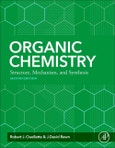Organic Chemistry: Structure, Mechanism, Synthesis, Second Edition, provides basic principles of this fascinating and challenging science, which lies at the interface of physical and biological sciences. Offering accessible language and engaging examples and illustrations, this valuable introduction for the in-depth chemistry course engages students and gives future and new scientists a new approach to understanding, rather than merely memorizing the key concepts underpinning this fundamental area. The book builds in a logical way from chemical bonding to resulting molecular structures, to the corresponding physical, chemical and biological properties of those molecules.
The book explores how molecular structure determines reaction mechanisms, from the smallest to the largest molecules-which in turn determine strategies for organic synthesis. The book then describes the synthetic principles which extend to every aspect of synthesis, from drug design to the methods cells employ to synthesize the molecules of which they are made. These relationships form a continuous narrative throughout the book, in which principles logically evolve from one to the next, from the simplest to the most complex examples, with abundant connections between the theory and applications.
Featuring in-book solutions and instructor PowerPoint slides, this Second Edition offers an updated and improved option for students in the two-semester course and for scientists who require a high quality introduction or refresher in the subject.
Please Note: This is an On Demand product, delivery may take up to 11 working days after payment has been received.
Table of Contents
1. Structure and Bonding in Organic Compounds 2. Functional Groups and Their Properties 3. Introduction to Organic Reaction Mechanisms 4. Alkanes and Cycloalkanes: Structures and Reactions 5. Stereochemistry 6. Alkenes Structures and Properties 7. Alkenes: Addition Reactions 8. Alkynes 9. Haloalkanes and Alcohols: Introduction to Nucleophilic Substitution and Elimination Reactions 10. Nucleophilic Substitution and Elimination Reactions 11. Conjugated Alkenes and Allylic Systems 12. Arenes and Aromaticity 13. Electrophilic Aromatic Substitution 14. Methods for Structure Determination Nuclear Magnetic Resonance and Mass Spectrometry 15. Alcohols: Reactions and Synthesis 16. Ethers and Epoxides 17. Aldehydes and Ketones 18. Aldehydes and Ketones: Nucleophilic Addition Reactions 19. Carboxylic Acids 20. Carboxylic Acid Derivatives 21. Condensation Reactions of Carbonyl Compounds 22. Amines and Amides 23. Aryl Halides, Phenols, and Anilines 24. Organometallic Chemistry of Transition Metal Elements and Introduction to Retrosynthesis 25. Pericyclic Reactions 26. Carbohydrates 27. Amino Acids, Peptides, and Proteins 28. Synthetic Polymers








